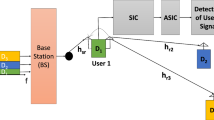Abstract
Maximizing system capacity is one of the major concerns in inband full-duplex (IFD) two-way relay (TWR) system using analog network coding (ANC). This paper compares 1-transmission-time-interval (TTI)-based ANC (1TA) TWR, in which each node operates in IFD mode, with 2-TTI-based ANC (2TA) TWR operating in inband half-duplex mode. System capacity of the 1TA TWR is derived with adverse factor such as direct link interference (DLI). Also, this work proposes an iterative optimal power allocation (OPA) method to maximize the system capacity, which is based on golden section search under total power constraint. Numerical results elucidate that the 1TA TWR based on the OPA outperforms the 2TA TWR in all cases of relay position and DLI.



Similar content being viewed by others
Notes
For simplicity and clearness, only one shared antenna for both transmission and reception is assumed since further analysis is straightforward in case of multiple shared antennas.
It assumes that \(\tau\) may be controlled integer by integer, and the propagation delay difference between \(S_1\)–R and \(S_2\)–R links is ignored.
Perfect cancellation is assumed in this work, so we consider exact channel state information (CSI) for each link. In reality, the CSIs are not able to be estimated perfectly although the CSI acquisition process was proposed in [7]. Thus, for further study the effect of the CSI error on the 1TA-ANC system should be analyzed with an aid of [16].
The capacity of DR = 0.25 is identical to that of DR = 0.75 because of the deployment scenario.
References
Basaran, S. T., et al. (2016). A tutorial on network coded cooperation. IEEE Communications Surveys and Tutorials, 18(4), 2970–2990.
Park, J. C., Wang, J. S., & Kim, Y. H. (2011). Rate and outage performance of non-regenerative two-way relay protocols with direct link. In IEEE VTC 2011 Fall
Louie, R. H. Y., Li, Y., & Vucetic, B. (2010). Practical physical layer network coding for two-way relay channels: Performance analysis and comparison. IEEE Transactions on Wireless Communications, 9(2), 764–777.
Wang, S., Song, Q., Wang, X., & Jamalipour, A. (2011). Rate and power adaptation for analog network coding. IEEE Transactions on Vehicular Technology, 60(5), 2302–2313.
Riihonen, T., Werner, S., & Wichman, R. (2009). Comparison of full-duplex and half-duplex modes with a fixed amplify-and-forward relay. IEEE WCNC, 2009, 1–5.
Popovski, P., & de Carvalho, E. (2008). Improving the rates in wireless relay systems through superposition coding. IEEE Transactions on Wireless Communications, 7(12), 4831–4836.
Ju, H., Oh, E., & Hong, D. (2009). Catching reource-devouring worms in next-generation wireless relay systems: Two-way relay and full-duplex relay. IEEE Communications Magazine, 47(9), 58–65.
Ju, H., Oh, E., & Hong, D. (2009). Improving efficiency of resource usage in two-hop full duplex relay systems based on resource sharing and interference cancellation. IEEE Transactions on Wireless Communications, 8(8), 3933–3938.
Wang, Y., Xu, K., Liu, A., & Xia, X. (2017). Hybrid one-way full-duplex/two-way half-duplex relaying scheme. IEEE Access, 5, 7737–7745.
Jain, M., et al. (2011) Practical, real-time, full duplex wireless. In IEEE Mobicom
Bhardia, D., McMilin, E., & Katti, S. (2013). Full duplex radios. In SIGCOMM
Riihonen, T., Werner, S., & Wichman, R. (2011). Hybrid full-duplex/half-duplex relaying with transmit power adaptation. IEEE Transactions on Wireless Communications, 10(9), 3074–3085.
Day, B., Margetts, A., Bliss, D., & Schniter, P. (2012). Full-duplex MIMO relaying: Achievable rates under limited dynamic range. IEEE Journal on Selected Areas in Communications, 30(8), 1541–1553.
Shin, W., Lee, N., Lim, J. B., & Shin, C. (2009). An optimal transmit power allocation for the two-way relay channel using physical-layer network coding. In IEEE ICC, 2009
Yuan, Q., Zhou, Y., Zhao, M., & Yang, Y. (2011). Optimal transmission power allocation for two-way relay channel using analog network coding. IEEE CECNet, 2011, 4243–4246.
Tabataba, F. S., Sadeghi, P., Hucher, C., & Pakravan, M. R. (2012). Impact of channel estimation errors and power allocation on analog network coding and routing in two-way relaying. IEEE Transactions on Vehicular Technology, 61(7), 3223–3239.
Boyd, S., & Vandenberghe, L. (2004). Convex optimization. Cambridge: Cambridge University Press.
Stoer, J., et al. (2002). Introduction to numerical analysis (3rd ed., pp. 289–363). Berlin: Springer.
Funding
This research was supported by Basic Science Research Program through the National Research Foundation of Korea (NRF) funded by the Ministry of Science, ICT & Future Planning (NRF-2016R1C1B1014968).
Author information
Authors and Affiliations
Corresponding author
Additional information
Publisher's Note
Springer Nature remains neutral with regard to jurisdictional claims in published maps and institutional affiliations.
Rights and permissions
About this article
Cite this article
Chang, K., Choi, Y. Feasibility and Optimization of 1-TTI-Based Full-Duplex Two-Way Relay System. Wireless Pers Commun 110, 1513–1522 (2020). https://doi.org/10.1007/s11277-019-06798-w
Published:
Issue Date:
DOI: https://doi.org/10.1007/s11277-019-06798-w




